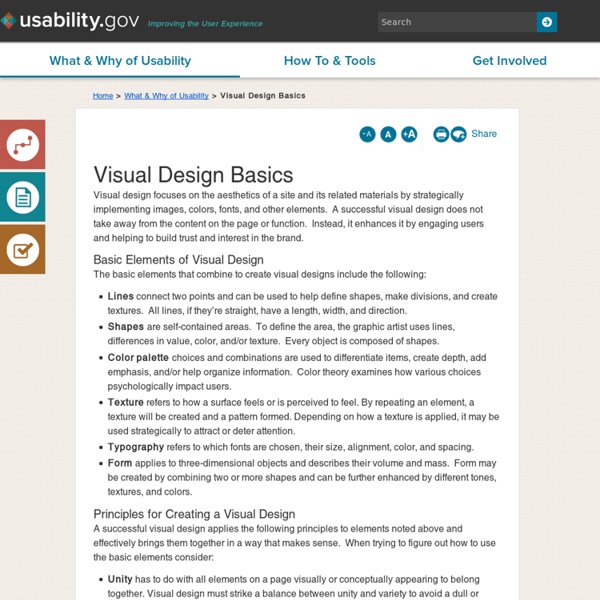



Elements and principles of design The elements and principles of design are the building blocks used to create a work of art. The elements of design can be thought of as the things that make up a painting, drawing, design etc. Good or bad - all paintings will contain most of if not all, the seven elements of design. The Principles of design can be thought of as what we do to the elements of design. How we apply the Principles of design determines how successful we are in creating a work of art. note - the hyperlinks within the text of this page will open information in a new browser window. LINE Line can be considered in two ways. SHAPE A shape is a self contained defined area of geometric or organic form. DIRECTION All lines have direction - Horizontal, Vertical or Oblique. SIZE Size is simply the relationship of the area occupied by one shape to that of another. TEXTURE Texture is the surface quality of a shape - rough, smooth, soft hard glossy etc. COLOUR Also called Hue see notes on colour
Clean Up Your Mess - A Guide to Visual Design for Everyone The Principles of Design The web professional's online magazine of choice. In: Columns > Design in Theory and Practice By Joshua David McClurg-Genevese Published on June 13, 2005 Starting with the Basics This column is about Web design—really, it is—though it may at times seem a bit distant and distracted. We can group all of the basic tenets of design into two categories: principles and elements. Web design is a relatively new profession compared to other forms of design, due to the youth of our medium. How Does Web Design Fit In? I tend to define Web design as being one of many disciplines within the larger field of design (a peer to print design, industrial design, interior design, etc.). The first three articles of this column will be dedicated to unearthing these universal gems of insight so that we may better understand our profession. The Principles of Design There are many basic concepts that underly the field of design. Let’s begin by focusing on the principles of design, the axioms of our profession. Rhythm
Principles of Design What is good visual design? “As little design as possible,” according to influential designer, Dieter Rams. However, what Rams does not explain is that good visual design needs foundation—principles that are followed rigorously to accommodate innovation and aesthetic. Good design is as little design as possible. Consistency Consistency means creating an interface that fits together in a family of different resolutions and mobile apps—making sure that the same elements are being repeated to match each page. You’d be able to recognize Facebook’s branding anywhere. Alignment Alignment is when two elements are connected by an invisible path or a visual connection. Twitter has two notable columns in their web app. Lined up and pretty. Proximity Elements need to be grouped in a logical manner. Put a grid on it! Contrast Contrast happens when two related elements are different. Good color contrast will also attract the user’s eye to the most important aspect of the page (as seen here on Spotify).
Composition and the Elements of Visual Design Proportion - Golden Ratio and Rule of Thirds Proportion refers the size relationship of visual elements to each other and to the whole picture. One of the reasons proportion is often considered important in composition is that viewers respond to it emotionally. Many photographers and artists are aware of the rule of thirds, where a picture is divided into three sections vertically and horizontally and lines and points of intersection represent places to position important visual elements. On analyzing some of my favorite photographs by laying down grids (thirds or golden ratio in Adobe Photoshop) I find that some of my images do indeed seem to correspond to the rule of thirds and to a lesser extent the golden ratio, however many do not. In summary, proportion is an element of design you should always be aware of but you must also realize that other design factors along with your own unique sensitivity about the subject dictates where you should place items in the viewfinder.
The Official 'Successful Website Checklist Challenge' If your website doesn't stand out and do a heck of a lot of things right, then chances are it's going to crash and burn. Take our "Successful Website Checklist Challenge" (below) and see what you're doing right, what you're doing wrong, and what you're forgetting to do. We've even included notes and resources for nearly every item on the checklist (just to make your life easier). This page doubles as a comprehensive article/checklist. Although our "Successful Website Checklist" is pretty thorough, we consider it a work in progress.